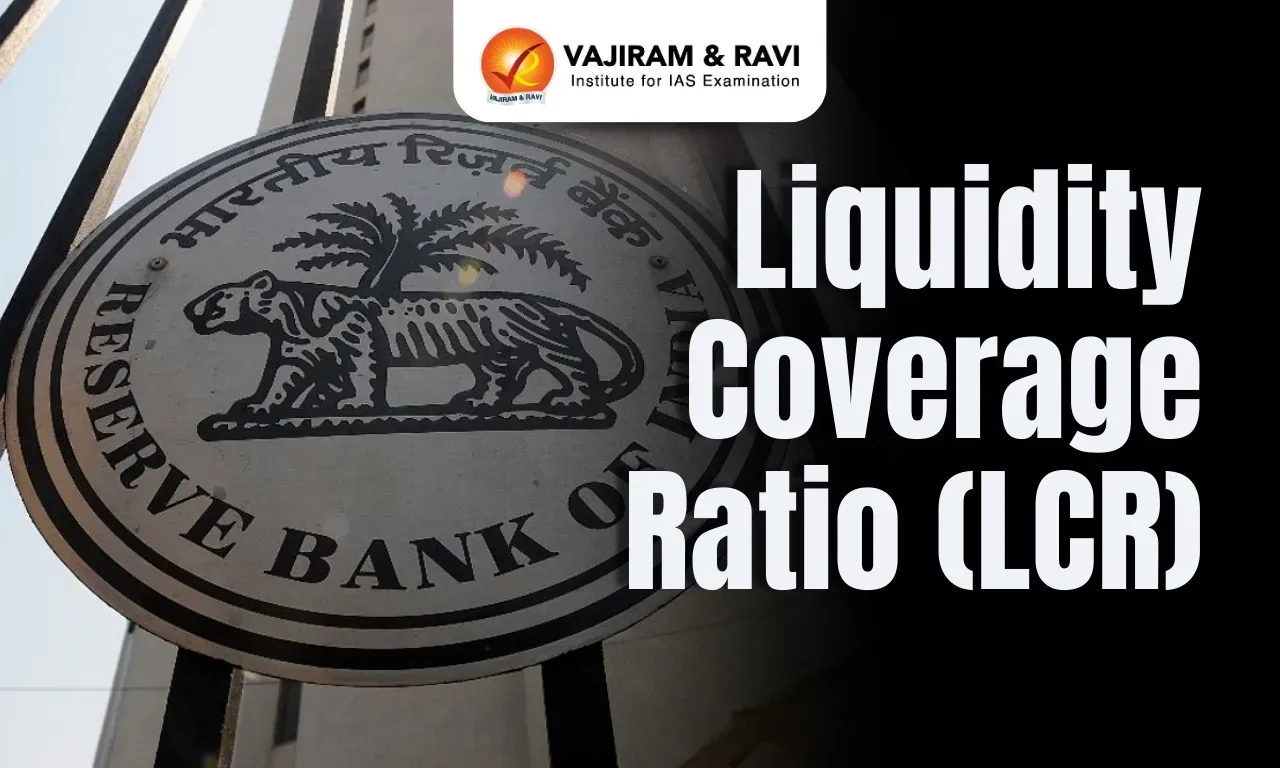What’s in Today’s Article?
- Liquidity Coverage Ratio (LCR) Latest News
- Liquidity Coverage Ratio (LCR)
- RBI Releases Final LCR Norms
- Liquidity Coverage Ratio (LCR) FAQs
Liquidity Coverage Ratio (LCR) Latest News
- The Reserve Bank of India (RBI) has relaxed the Liquidity Coverage Ratio (LCR) norms by introducing a new requirement: banks must now assign an additional 2.5% run-off factor to retail deposits accessible via internet and mobile banking (IMB) services.
- A run–off factor refers to the percentage of deposits that a bank expects to be withdrawn in a short-term period of stress.
Liquidity Coverage Ratio (LCR)
- The LCR is a regulatory standard designed to ensure that banks hold enough high-quality liquid assets (HQLAs) to cover their total net cash outflows over a 30-day stress period.
- It acts as a financial stress test to protect against short-term liquidity disruptions.
Origin and Implementation
- The LCR was developed by the Basel Committee on Banking Supervision (BCBS) following the global financial crisis.
- Proposed in 2010 and finalized in 2014, the rule became fully applicable with a 100% minimum requirement in 2019.
- It primarily applies to large banks with over $250 billion in assets or $10 billion in foreign exposure.
LCR Formula
- LCR = High-Quality Liquid Assets (HQLA) / Total Net Cash Outflows (30 days)
- The ratio reflects a bank’s ability to survive a liquidity crunch for 30 days without external support.
High-Quality Liquid Assets (HQLA)
- In India, High Quality Liquid Assets (HQLA) are assets that banks and other financial institutions hold to meet short-term liquidity needs, especially during periods of stress.
- These assets are readily convertible to cash with minimal loss in value and are considered to be low-risk and of high credit quality.
- They serve as a safety net, ensuring institutions can meet their funding obligations promptly.
- E.g., – Cash and Balances with the RBI; Government Securities etc.
Limitations of LCR
- Reduced Lending Capacity: Holding excess liquidity may limit banks’ ability to offer loans.
- Uncertain Effectiveness: The real test of LCR’s adequacy will come only during a future financial crisis.
RBI Releases Final LCR Norms
- RBI has finalized and released the Liquidity Coverage Ratio (LCR) guidelines.
- A key update includes an additional 2.5% run-off factor for internet and mobile banking (IMB)-enabled deposits of retail and small business customers.
- This is a reduction from the earlier proposed 5%.
Digital Deposits and Run-off Factors
- IMB-enabled stable retail deposits will now attract a 7.5% run-off factor (up from 5%).
- IMB-enabled less stable deposits will have a 12.5% run-off factor (up from 10%).
- IMB includes services like internet banking, mobile banking, and UPI.
Implementation Timeline
- The revised norms will be effective from April 1, 2026 and apply to all commercial banks, excluding payments banks, regional rural banks, and local area banks.
- During meetings with RBI in January 2025, both public and private banks requested a deferment of LCR implementation, citing preparedness concerns.
- Originally proposed in July 2024, the RBI had called for a 5% additional run-off for IMB-enabled deposits, which sparked industry feedback.
Impact on Liquidity and Lending
- The RBI estimates that the banking system’s LCR will improve by 6% as of December 31, 2024.
- With Rs 45–50 lakh crore in HQLAs, the relaxation could free up Rs 2.7–3 lakh crore in lendable resources.
- This may support an additional credit growth of 1.4–1.5%, boosting economic activity.
Liquidity Coverage Ratio (LCR) FAQs
Q1. What is LCR?
Ans. LCR ensures banks hold enough liquid assets to cover 30-day cash outflows in stress situations.
Q2. Why did RBI revise LCR norms?
Ans. To manage risks from volatile digital deposits and strengthen liquidity in digital banking systems.
Q3. What is the new run-off factor?
Ans. A 2.5% additional run-off for internet and mobile banking-enabled deposits of retail and small businesses.
Q4. When will the new rule be effective?
Ans. From April 1, 2026, across commercial banks (excluding payments and rural banks).
Q5. How will this impact lending?
Ans. Relaxed norms could unlock ₹2.7–3 lakh crore in lending, boosting credit growth by 1.4–1.5%.
Last updated on June, 2025
→ UPSC Notification 2025 was released on 22nd January 2025.
→ UPSC Prelims Result 2025 is out now for the CSE held on 25 May 2025.
→ UPSC Prelims Question Paper 2025 and Unofficial Prelims Answer Key 2025 are available now.
→ UPSC Calendar 2026 is released on 15th May, 2025.
→ The UPSC Vacancy 2025 were released 1129, out of which 979 were for UPSC CSE and remaining 150 are for UPSC IFoS.
→ UPSC Mains 2025 will be conducted on 22nd August 2025.
→ UPSC Prelims 2026 will be conducted on 24th May, 2026 & UPSC Mains 2026 will be conducted on 21st August 2026.
→ The UPSC Selection Process is of 3 stages-Prelims, Mains and Interview.
→ UPSC Result 2024 is released with latest UPSC Marksheet 2024. Check Now!
→ UPSC Toppers List 2024 is released now. Shakti Dubey is UPSC AIR 1 2024 Topper.
→ Also check Best IAS Coaching in Delhi
























